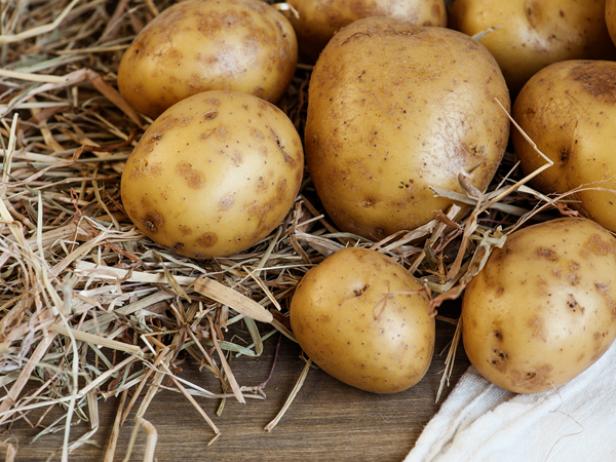Don’t let your harvest go to waste.
Oftentimes, when harvesting fall garden vegetables, there is more food than can be consumed, especially when crops reach their optimal size at the same time. Although there’s nothing better than filling up a basket of potatoes right from your backyard, seeing them spoil due to lack of proper storage is the pits.
But the good news is fall crops can be easily stored indoors to be enjoyed over the winter – and you don’t have to have a root cellar, either. Many vegetables (especially fall crops like root vegetables) will keep for months if stored in the right conditions. Here’s how to enjoy the taste of your garden all winter long.

Alinakho/Getty
Cold Storage Basics
The three main factors to consider when storing food in your home are temperature, humidity and darkness. Keep in mind, although the method is called “cold storage,” it does not mean storing vegetables in the refrigerator. Refrigerators provide an environment that’s best suited for vegetables that will be consumed within a few days.
“Cold storage” actually means storing freshly picked foods in a cool but not freezing environment. If you don’t have a root cellar, you can effectively store your garden picks in a basement, entryway or an unheated spare room. Any area that fits the description of a cold storage environment will work just fine.
The Three Combinations for Cold Storage
Cool and Dry: 50 to 65 degrees F and 60 percent relative humidity, such as basements. If your basement is on the moist side, you can use a dehumidifier to provide the desired environment.
Cold and Dry: 40 degrees F and 60-70 percent relative humidity, such as refrigerators. Onions store well in the fridge long-term but not much else.
Cold and Moist: 35 to 55 degrees F and 70 to 95 percent relative humidity, such as root cellars or any room that remains above freezing.
A root cellar (or similar storing area) can provide cold and moist conditions, as where basements can provide a cool and dry to a semi-moist environment, typically. Purchasing temperature and humidity gauges for your storage room will let you know if adjustments need to be made.
The Two Categories of Vegetables for Storing
Cold-storage vegetables are divided into two categories: ‘Dry’ and ‘Moist,’ and are stored in different ways.
Moist Vegetables: Root crops (e.g. beets, carrots, parsnips, rutabaga), potatoes and cabbage call for more humid conditions. Rather than being exposed to dry air, it’s best to store these vegetables covered to protect them.
To keep moist-storing vegetables thriving, cover them with insulating materials such as dry peat moss, sawdust or sand. Simply fill a cardboard box with 4 inches of insulating material, without letting the vegetables overlap. Make sure the vegetables remain at least four inches away from the sides of the box. Cover the vegetables with an additional two-to-three-inch layer of peat moss and add another single layer of vegetables. Repeat these steps until you reach the box’s top and end with a layer of peat moss.
Dry Vegetables: Onions, garlic, squash and pumpkins are easy veggies to store, require less humidity, but need a little more space. They don’t need to be kept in a box or container. When storing, keep them off of the floor and don’t let them touch one another.
These Foods Don’t Pair Well When Storing
Vegetables and Fruits: Pairing these two together can cause accelerated ripening due to ethylene, a gas produced by many fruits which will cause the vegetables around them to ripen too quickly. For example, if you store an avocado with an apple, the avocado will ripen at a faster speed and the shelf-life will be cut short. For many veggies, this means spoiling.
Fruits that are high producers of ethylene are apples, pears, kiwi, peaches, apricots and nectarines.
Onions and Potatoes: Onions omit excess moisture which can cause potatoes to sprout. Along with excess moisture, when stored together, onions also put off ethylene which will cause the potatoes to spoil.
Lifespan for Cold and Moist Storage Vegetables
Beets: Five months
Carrots: Eight months
Parsnips: Four months
Potatoes: Six months
Rutabaga: Four months
Turnips: Three to four months
Winter Squash: Two to six months
Other Cold and Moist Storing Vegetables with a Shorter Shelf-Life
Asparagus: Two weeks
Broccoli: Two weeks
Brussels Sprouts: One month
Corn: Five days
Cantaloupe: One week
Cauliflower: Three weeks
Lettuce: One week
Peas: One week
Snap Beans: One week
Spinach: One week
Cold Storage Tips
- Store only fully mature (or slightly under-ripe), healthy-looking vegetables that have not been bruised or damaged
- Remove all excess soil from the vegetables before storing but do not wash them; it can cause them to ripen. Wash them well when you plan to consume them.
- Keep your storage area dark to prevent the vegetables from sprouting
- Check your stored vegetables once a week – if you notice softening, it’s time to cook them
- Consume your vegetables regularly and don’t plan on or expect extended storage life (especially if it’s your first time storing). This will ensure that all vegetables will be consumed before they expire.
Create a DIY Outdoor Underground Root Cellar
If you lack space inside your home for food storage and feel up to a one-day project, you can easily create a mock root cellar in your yard in the ground.
Tools Needed: Trash can, bucket or similar container that can withstand cold temperatures, a shovel, straw, a drill and rocks or stones
Directions:
- Dig a hole in the ground that will fit the size of your container. The open part of the container should sit about 4 inches above the ground to allow for access and proper sealing of the container lid. The hole dug needs to be at least 1-foot-deep in the ground to provide cool enough temps for the stored food.
- Fill the bottom of the hole with a few inches of loose stones or rocks to allow proper drainage.
- Drill several holes in the bottom of your container to allow drainage.
- Place the container in the ground (on the stones) and put a single layer of straw inside the bottom of the container.
- Layer the vegetables over the straw and cover them with straw. It should look like: Straw, vegetables, straw, vegetables, last layer straw. The vegetables should not overlap.
- Place the lid on the container snugly, and cover with straw.
- Optional: Place a sheet of plywood, or an object over the mock-root cellar to prevent critters from breaking in. Consume the vegetables as needed.

